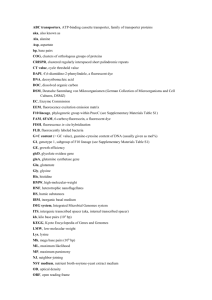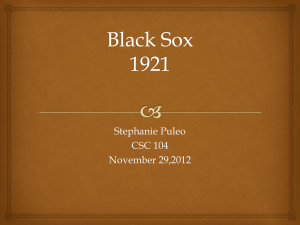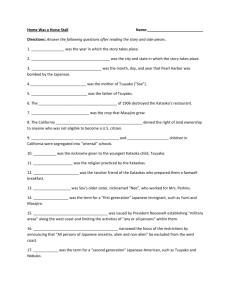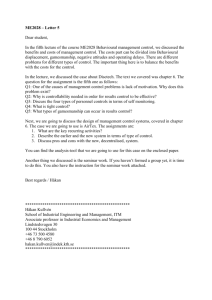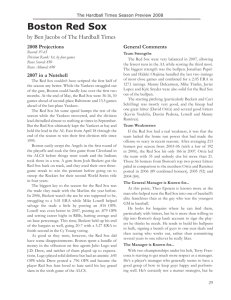Informative Speech (Event)
advertisement
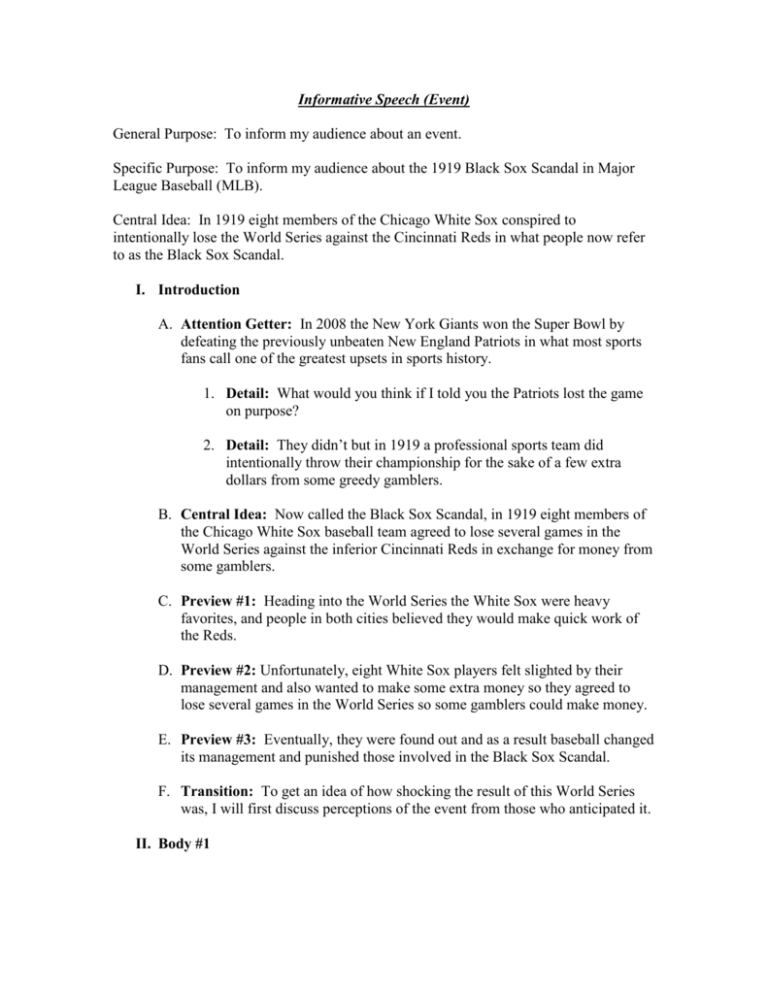
Informative Speech (Event) General Purpose: To inform my audience about an event. Specific Purpose: To inform my audience about the 1919 Black Sox Scandal in Major League Baseball (MLB). Central Idea: In 1919 eight members of the Chicago White Sox conspired to intentionally lose the World Series against the Cincinnati Reds in what people now refer to as the Black Sox Scandal. I. Introduction A. Attention Getter: In 2008 the New York Giants won the Super Bowl by defeating the previously unbeaten New England Patriots in what most sports fans call one of the greatest upsets in sports history. 1. Detail: What would you think if I told you the Patriots lost the game on purpose? 2. Detail: They didn’t but in 1919 a professional sports team did intentionally throw their championship for the sake of a few extra dollars from some greedy gamblers. B. Central Idea: Now called the Black Sox Scandal, in 1919 eight members of the Chicago White Sox baseball team agreed to lose several games in the World Series against the inferior Cincinnati Reds in exchange for money from some gamblers. C. Preview #1: Heading into the World Series the White Sox were heavy favorites, and people in both cities believed they would make quick work of the Reds. D. Preview #2: Unfortunately, eight White Sox players felt slighted by their management and also wanted to make some extra money so they agreed to lose several games in the World Series so some gamblers could make money. E. Preview #3: Eventually, they were found out and as a result baseball changed its management and punished those involved in the Black Sox Scandal. F. Transition: To get an idea of how shocking the result of this World Series was, I will first discuss perceptions of the event from those who anticipated it. II. Body #1 A. Topic Sentence: Throughout the time leading up to the 1919 World Series, reporters in both Chicago and Cincinnati spoke about how good the World Series would be, and the odds-makers listed the White Sox as heavy favorites. B. Supporting Sentence #1: The Peter Gammons of the time, former MLB pitcher Cristy Mathewson, predicted the best played series in years (October 1, 1919, p. 13). 1. Detail: He gave the edge on pitching to the Reds, but believed the White Sox offense and experience gave them a better chance at victory (October 1, 1919, p. 13). 2. Detail: He also pointed to the fact the Sox played in a better league and had a tougher road to the series, making them ready for a fight (October 1, 1919, p. 13). C. Supporting Sentence #2: Gamblers also made the White Sox heavy favorites in the World Series. 1. Detail #1: The Cincinnati Inquirer claimed that through September 29 the Reds received little moral than moral support (“Red Money Appears,” October 1, 1919, 16). 2. Detail #2: Only when rumors about a White Sox pitcher’s health started to swirl did the money on the Reds start to appear, but even still the White Sox remained the favorites to win in New York, the center for gambling activity (“Ruether to Oppose,” October 1, 1919, 13). D. Supporting Sentence #3: Even with injuries and an apparently strong matchup between the White Sox and the Reds, everyone felt at the outset that the White Sox would win. E. Transition: Little did the odds-makers and reports know, but several White Sox players felt slighted by the way management treated them, making them less inclined to play well for the championship. III. Body #3 A. Topic Sentence: Despite how good the team was, the players played for an owner who tried to squeeze every penny out of them he could, and thus they felt the need to get back at him and make a few bucks by teaming with gamblers and throwing a few games. B. Supporting Sentence #1: Charles Comisky, the owner of the White Sox, had treated his players poorly and not rewarded them for the successes they achieved. 1. Detail #1: In fact, Comisky had not given his players a raise since 1915, and in those days players did not make nearly as much money as they do today (Burk, 1994, p. 233). 2. Detail #2: Comisky also was the only owner who charged his own players to launder their uniforms (Burk, 1994, p. 236-240). 3. Detail #3: As if that was not enough, he also benched his best pitcher, Eddie Cicotte, for the last month of the season to keep him from receiving a bonus for number of wins in a season (Asinof, 1963). C. Supporting Sentence #2: So, Comisky’s practices set the stage for White Sox players, led by Arnold “Chick” Gandil to make a deal with gamblers to throw some games in the Series to make some money and make their owner sweat. 1. Detail #1: The players were only supposed to lose a handful of games, but when the gamblers saw how lucrative the fix was they forced the players to lose more (Burk, 1994, p. 236-240). 2. Detail #2: Additionally, the gamblers never paid the eight corrupt players all the money they promised them (Burk, 1994, p. 236-240). 3. Detail #3: Ultimately, the White Sox lost the Series in eight games, but it was never close. D. Supporting Sentence #3: Shortly following the conclusion of the World Series, writers Ring Lardener and Cristy Mathewson compared notes and believed the White Sox threw the Series. E. Transition: When the law and the league looked into whether there was a scandal, they made several important decisions regarding the players and the game of baseball. IV. Body #3 A. Topic Sentence: With questions swirling about the integrity of the 1919 World Series, both the government and MLB looked into the situation. B. Supporting Sentence #1: The following year the District Attorney’s Office in Cook County of Illinois investigated and charged quite a few White Sox players with conspiring to throw the World Series. 1. Detail #1: The players were acquitted of the legal charges mainly because two signed confessions disappeared during the trial (Bachin, 2003, p. 943). C. Supporting Sentence #2: In response to the rumors of the White Sox throwing the Series, and the subsequent Cook County investigation, the owners of major league baseball teams hired a commissioner with unlimited power to clean up the image of the sport. 1. Detail #1: They named Federal Judge Kennesaw Mountain Landis as commissioner, and he promptly suspended all eight of the accused players from baseball for life (Rosenberg, 1987, p. 129-146). 2. Detail #2: His statement on the issue was simple: “Regardless of the verdict of juries, no player who throws a ball game, no player who undertakes or promises to throw a ball game, no player who sits in confidence with a bunch of crooked ballplayers and gamblers, where the ways and means of throwing a game are discussed and does not promptly tell his club about it, will ever play professional baseball” (Rosenberg, 1987, p. 129-146). 3. Detail #3: Regardless of courts, Landis found the men guilty of what many now believe is the greatest crime against the game a player or manager can commit. D. Supporting Sentence #3: The guilt Landis attributed to the players, combined with the team name, became the origin of the nickname given to this scandal. E. Transition: The suspension from the game they loved became an even harsher penalty than anything the courts could have imposed. V. Conclusion A. Signpost: So, as you can see, the 1919 Black Sox Scandal represented one of the worst cheating scandals in professional sports history. B. Summary #1: The Chicago White Sox entered the World Series in 1919 as heavy favorites over the Cincinnati Reds. C. Summary #2: Despite their talent, their ownership created an atmosphere where the players felt the need to seek money elsewhere, including from gamblers. D. Summary #3: Ultimately, the players were cheated out of their money from the gamblers, and eventually were suspended from baseball for life as a result of their dishonest actions. E. Restate Thesis: The Black Sox Scandal was the largest conspiracy in baseball history, and was the fault of greedy owners, greedy players and greedy gamblers. F. Clincher: Unfortunately, it is the very real actions of teams like the White Sox that make people pause and consider whether upsets like the Giants in the Super Bowl are truly upsets, or something more sinister. Bibliography Mathewson, Christy. (1 October 1919). Pitching is most important factor: Real test for managers rests in naming boxmen and making changes, says Matty; Cicotte may not be fit. New York Times, 13. “Red money appears.” (1 October 1919). Chicago Daily Tribune, 16. “Ruether to oppose Cicotte in the opener: Moran announces that left-hander will pitch against White Sox today.” (1 October, 1919). New York Times, 13. Burk, Robert F. (1994). Never just a game: Players, owners, and American baseball to 1920. Chapel Hill, NC: University of North Carolina Press. Asinof, Eliot. (1963). Eight Men Out: The Black Sox and the 1919 World Series, New York, NY: Henry Holt. Bachin, Robin F. (2003). At the nexus of labor and leisure: Baseball, nativism, and the 1919 Black Sox Scandal. Journal of Social History, 36 (1), 943. Rosenberg, Norma L. (1987). Here comes the judge: The origins of baseball’s commissioner system and American legal culture. Journal of Popular Culture 20 (4), 129-146.

